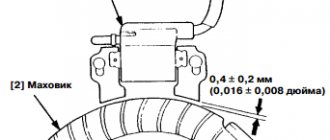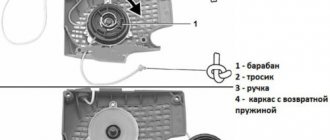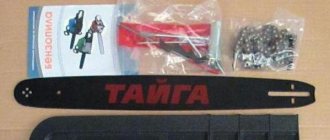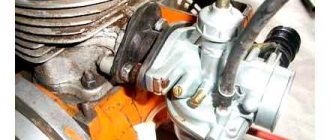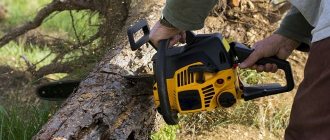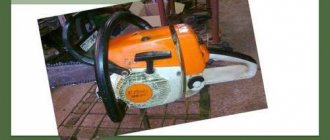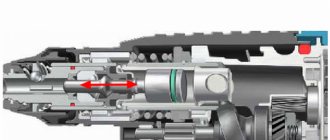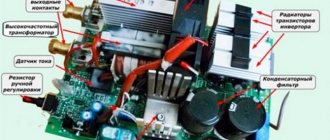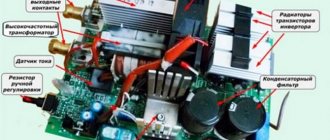Related Posts
Carburetor Sthil MS180 (Shtil 180). Adjustment - no, I haven’t heard...
The Stihl MS 180 chainsaws produced at the moment and in the last couple of years are equipped with Chinese-made carburetors, which have only one adjustment screw. Diagnosis of the main malfunctions of chainsaws and repair of Makita chainsaws. And also cleaning the petrol carburetor. Such membrane-type carburetors actually cannot be disassembled, since it is completely sealed and filled. So to say: “Adjustment - no, I haven’t heard...” In this case, it is easier to purchase a Shtil 180 chainsaw carburetor, while carburetors are available for sale both unique (also made in China, but at a plant owned by STIHL) and from third-party (also Chinese) manufacturers.
It should be noted that despite being a Chinese creation, the unique Shtil 180 carburetors are very reliable and rarely let their owners down. The cost of a unique carburetor for a Stihl 180 and a non-unique carburetor varies greatly. For example, if a non-original carburetor on the Internet costs from 700 rubles, then a unique one costs 2,500 rubles, in other words, almost 4 times more expensive.
For chainsaws manufactured for 5 or more years, you can purchase repair kits. The cost of a repair kit for a Shtil 180 carburetor ranges from 200 to 400 rubles.
Stihl ms 180 carburetor repair
How to disassemble for cleaning and replacing the repair kit?
In order to clean, change gaskets or needle valve, the carburetor must be disassembled. To do this, you need to unscrew 4 screws on the compensator cover and one on the fuel pump.
Once you open the housing, you should be extremely careful, because if debris gets inside the carburetor, it will make it impossible to operate. The thickness of the channels in it is comparable to the thickness of a thread or even a human hair.
A video on repairing a Shtil 180 carburetor can be viewed below. In it, the master talks in detail about the problems and clearly demonstrates the entire repair process.
Cleaning the carburetor of a STIHL chainsaw
Hello, dear reader. Today I’ll tell you how to repair a STIHL chainsaw in one hour with your own hands in the field, without interrupting production. Many of us have a lawn mower, chainsaw or cultivator. What to do if the device stops working normally, namely, it stalls, won’t start, won’t idle, loses power, unstable engine operation? Some people take a screwdriver and start turning the carburetor adjustments, which is not recommended. It is easy to reset the factory settings, but restoring it will be problematic later. Let's start repairing the carburetor of any gasoline-powered device by thoroughly cleaning it. And then you can adjust the speed, if you know how to do it.
Most often, all problems are caused by dirt, dust, sawdust or water in the carburetor.
Not everyone knows that you can deal with this problem yourself. Service can be far away, it takes a lot of time and effort if, for example, your medium-sized cultivator is broken, which is dirty, large and also weighs 50 kg. and more. Therefore, it will be easier for us, if we have free time, to do the repair of the Stihl chainsaw with our own hands .
Appearance of the chainsaw calm
The principle of my repair is one - the eyes are afraid, the hands do it. The main thing is not to lose or break anything; all carburetors are cleaned almost the same way and the result will not be long in coming. We will repair the Stihl chainsaw. We will need some gasoline (residues from the tank will do just fine or pure gasoline), a 8mm socket and a Phillips screwdriver, or any brush to brush off external dirt. I blow all the parts with a compressor. If there is no compressor, then wash it in clean gasoline.
Use a brush to remove dust and dirt. Remove the cover. Remove the filter.
Main types of breakdowns and methods for eliminating them
Before starting work on diagnosing faults and eliminating them, you must prepare the necessary tools.
General view of the Stihl MS 180 chainsaw with main components
Due to the fact that a chainsaw is a relatively simple unit, the list of accessories includes the following items:
- a set of flat and Phillips screwdrivers;
- open-end locksmith's wrenches;
- spark plug key;
- socket set with wrench
- Stihl multi-tool.
Multifunctional tool
In order to qualitatively eliminate any breakdowns that occur and restore operational performance, it is necessary to determine as accurately as possible the malfunction that preceded the failure of the unit. Based on the fact that the chainsaw is equipped with an internal combustion engine (ICE), the main causes of breakdowns should first of all be looked for in the power unit.
Before starting work, it is necessary to turn off the engine, allow it to cool and prevent the chainsaw from starting. To protect your fingers, it is recommended to wear cotton gloves.
The most common faults when repairing a Shtil 180 chainsaw include:
- the engine does not start;
- the engine runs intermittently, and when running for a short time, the chainsaw spontaneously stalls;
- oil leaks near the chain lubrication mechanism;
- the engine does not develop full power.
Frequent breakdowns of the transmission part of the saw include rupture of chain links. You can independently restore its integrity by riveting the links or replacing them with a new one.
Despite the relative simplicity of the design and the absence of complex mechanisms, experts recommend troubleshooting in a certain order. First of all, the presence of the mixture in the fuel tank is checked, and if everything is in order with the liquid level, you need to proceed to inspect the chainsaw starting unit. If this mechanism is also in normal condition, you need to check the functionality of the spark plug.
After performing the manipulations to diagnose the spark plug (determining the presence or absence of carbon deposits, the correct gap between the electrodes, the condition of the o-ring), we turn our attention to the carburetor. Due to small sawdust, dust and soil particles, the fuel system often becomes clogged.
If cleaning the carburetor of a stihl 180 chainsaw did not help restore the unit to its previous performance, the reason most likely lies in the cylinder-piston group (CPG). The power unit is one of the most complex mechanisms of the tool, the diagnosis of which requires almost complete disassembly.
Fuel system problems
The first stage of diagnosing the fuel supply system is checking the level of the fuel mixture in the tank.
The main components of the fuel system of the 180 Shtil chainsaw
Even if the owner is sure of the availability of gasoline, this makes it possible to eliminate the vacuum created as a result of a clogged bypass valve. It is designed to optimize pressure in the tank with fuel consumption. To make it easier to clean the chainsaw breather, use a regular medium-sized sewing needle.
When inspecting the fuel system, you should pay attention to the integrity of the pipes, the tightness of which may be compromised by mechanical damage or long-term operation of the unit. Sometimes the cause of mixture leakage and, as a result, incorrect engine operation, is the wear of rubber gaskets and primer (choke button). In this case, to repair the Shtil 180 chainsaw with your own hands, you need to purchase a repair kit for seals and replace them.
Problems with the starting and ignition mechanism
The cause of problems with a chainsaw of this model may be a malfunction of the ignition system and the engine starting unit.
General view of the 180 chainsaw ignition
If no deviations are detected when measuring the gap between the flywheel and the module, you need to pay attention to the spark plug.
Most manufacturers, including Shtil chainsaws, recommend setting a gap of 0.2 mm. To do this, you will need a coin-shaped, coin-wire or flat probe, which can be purchased at any automotive store.
Shtil 180 chainsaw starter assembly
Having removed the spark plug from the shaft, we measure the gap of the chainsaw spark plug between the central and side electrodes. If its value is excessive (more than 0.7-1.5 mm), a spark may occur periodically, and if it is minimal (less than 0.7 mm), it may not be sufficient for optimal ignition of the fuel mixture.
If gasoline enters the combustion chamber, and no discrepancy in the ignition system has been identified, the likely cause of the breakdown may be the carburetor. This unit is designed to mix fuel with air and supply them to the cylinder. After dismantling the carburetor, we clean its channels and jets using universal products.
It must be remembered that the carburetor consists of many small parts, and therefore its dismantling, disassembling and cleaning require special care.
After diagnosing the ignition system of the Shtil 180 chainsaw and restoring it, we move on to finding problems in the power unit, namely in the cylinder-piston group of the saw.
Chainsaw engine breakdowns
During operation, parts of the cylinder-piston group of the saw fail due to friction forces, high temperatures and loads. If the tool does not develop full power when starting up and stalls at idle, the possible problem may be broken engine parts. To disassemble the power unit, you need to unscrew 4 bolts and remove the cylinder. The owner needs to carefully inspect its internal working surface for the presence of chips, nicks and cracks.
Even the slightest damage to the cylinder “mirror” can negatively affect the compression of the chainsaw engine and its performance.
Cylinder piston group of Stihl MS180 chainsaw
When diagnosing an internal combustion engine, we also perform a visual inspection of the piston and compression rings. Made from duralumin alloy and cast iron, respectively, they are more subject to abrasive loads in contrast to a steel cylinder. If the piston rings are damaged or excessively worn, they must be replaced.
If upon visual inspection there is an ovality of the working surface of the cylinder, it will need to be bored. To do this, we measure its diameter according to the larger size, select the piston and carry out subsequent machining.
Malfunctions in the lubrication system of the 180 chainsaw: causes and repairs
During the process of sawing wood, the cutting part of the tool is subjected to high loads. In order to reduce friction forces and subsequent chain wear, the Stihl chainsaw is equipped with a lubrication system that gradually supplies oil to the bar. The rapid loss of cutting properties by the teeth and the absence of traces of lubricant may indicate leakage or clogging of the pipes.
Stihl 180 chain lubrication principle
First of all, when diagnosing the chain lubrication system for the ms 180 chainsaw, we pay attention to the oil supply hoses and their fixation points. Damaged pipes cannot be repaired and therefore must be replaced. You can clean the oil channels using compressed air. For these purposes, we use a compressor or a regular automobile hand pump.
Due to its ease of operation and repair, the chainsaw of this model has gained wide recognition among professionals and amateurs in the field of woodworking.
What carburetor is used on the Shtil 180 chainsaw
The Shtil 180 chainsaw is equipped with a Japanese Zama membrane-type carburetor. Some users are confused by the inscription China on the carburetor. Yes, indeed they are assembled in China. But the plant belongs to the Stihl company, and the quality still remains at a high level. However, the chainsaw also has Chinese copies with corresponding carburetors. But such saws are usually cheaper than the original.
Oil supply repair
The oil system in the Stihl 180 chainsaw is often damaged. Such a malfunction can be determined by the dryness of the operating chain or the presence of leakage.
The solution to this problem must begin with a thorough inspection of the hose through which the oil is supplied. The connection between the hose and the fittings can also be inspected.
During the inspection and repair of the oil system, it is also necessary to clean the filter. Often its contamination leads to poor oil flow.
If there is an oil leak, this means that the system has a leak. This primarily concerns the hose and oil channels. Most often, such malfunctions arise as a result of mechanical damage to system elements.
The process of removing and cleaning the air filter
If, as a result of the inspection, a violation of the integrity of the hose was determined, it is replaced. If the damage is minor, it can be hidden using sealant. This radical method will reduce the cost of repairs.
How does the Shtil 180 carburetor work: device, principle of operation
The main components of the Shtil 180 chainsaw carburetor include the following components:
- fuel pump (with internal diaphragm);
- main (membrane) chamber;
- diffuser;
- throttle and air dampers;
- needle valve;
- fuel jets;
- nozzle with valve;
- idle speed adjusting screw.
The principle of operation is this. The chainsaw crankcase is connected to the fuel pump in the carburetor by a special channel. Due to the alternating stroke of the piston, a vacuum is created in the engine crankcase. Due to this, the diaphragm in the fuel pump rises and the valve opens to supply fuel to the carburetor.
Next, the fuel passes through the filter element (mesh) and enters the main chamber through a special channel. A control membrane is installed in this chamber, which regulates the fuel supply by pressing the rocker arm, which in turn lowers the needle valve.
Raising the control membrane is responsible for the vacuum that occurs in the carburetor diffuser due to the rotation of the air throttle valves. As soon as the engine starts, the mixture needs to be leaner. We lower the air damper, the vacuum in the diffuser is minimal, and the membrane falls into place.
From the main chamber, fuel enters the diffuser using a nozzle with a check valve, or through idle jets (when the gas throttle is closed). There it is mixed with the intake air and the finished mixture enters the engine cylinder. The check valve prevents air from the diffuser from entering the main chamber.
Principle of operation
Before identifying a malfunction and repairing the Shtil 180 chainsaw, you should study the principle of its operation and what structural elements it consists of. A chainsaw must contain its main element - a two-stroke engine. It is he who is responsible for the reliability and performance of the device. The engine is involved in starting the chain drive and maintaining its movement under the influence of the centrifugal clutch. In addition to the electric motor, the chainsaw includes:
- starter;
- flywheel, also known as a cooling unit;
- ignition unit;
- clutch and brake mechanism;
- carburetor with STIHL compensator;
- air filter;
- fuel and oil tank;
- muffler;
- anti-vibration system.
Fuel from the tank enters the carburetor , where it is mixed with air coming from the cleaning unit. From the carburetor, a mixture of air and fuel enters the engine. The saw carburetor has one adjustment screw that controls the idle speed. All device settings are made at the factory and ensure optimal supply of the fuel-air mixture.
The mixture is ignited in the engine cylinder, and the engine is started using the starter. Under the action of the piston, the shaft that is part of the crank mechanism begins to move. There is a sprocket on the shaft onto which the chain links are placed.
The chainsaw uses a single-cylinder motor.
A clutch is used as a protection mechanism, which allows the electric motor to switch to idle mode in the event of a chain jam. At the initial revolutions, special linings located in the radial direction are pressed by springs to the middle of the shaft, thereby preventing it from rotating. At high speeds, centrifugal force increases, which leads to compression of the springs. The linings are pressed away from the center of the shaft, the sprocket rotates and the chain starts. The electrical circuit of the device is involved in the ignition system. Due to the use of a flywheel with magnets, an electromotive force (EMF) is generated during rotation, which leads to the appearance of current in the electronics unit. The block sends a signal to the spark plug, causing a spark to appear at its terminals. This spark ignites the mixture coming from the carburetor. After a successful start has occurred, the chainsaw begins to repeat all work processes in the cycle.
Adjusting the carburetor of the Shtil 180 chainsaw
Usually, special screws are responsible for the quantity and quality of fuel entering the diffuser, by adjusting which we change the cross-section of the fuel channel. But on the Shtil 180 chainsaw carburetor used, to facilitate the operation of the saw, these two screws are missing.
The channels are designed in such a way that the optimal amount of fuel enters the diffuser at all engine speeds. And the LD screw is responsible for the adjustment here, the rotation of which regulates the air supply to the idle jet. Due to what the engine speed changes.
So, to adjust the carburetor of the Stihl 180 chainsaw you will need a regular flat-head screwdriver and an electronic tachometer (optional). The adjustment algorithm is as follows:
- Check the air filter. If necessary, replace the filter element.
- Screw the LD screw counterclockwise until it ends, and then unscrew it 2 turns. Attention, left-hand thread! To access the screw, there is a hole for a screwdriver on the saw body. Start the engine and warm up for 5-7 minutes.
- By turning the LD screw slowly clockwise, we arbitrarily adjust the idle speed. 2 situations are possible: The engine speed at idle is very low. The engine does not idle. Turn the LD screw until the saw starts to rotate, and then turn the screw 1/2 back (the chain should stop).
- The saw spins at idle speed. In this case, slowly turn the screw counterclockwise until the chain stops, then turn the screw another 1/2 turn in the same direction.
Malfunctions and repairs
The carburetor of the Stihl 180 chainsaw requires both initial and periodic adjustment. You can find out about its need by the following signs:
- Problems with the engine, for example, it does not start or stalls immediately after starting. The most common cause is the use of a low-quality fuel mixture.
- Fuel consumption and increased emissions. Exhaust gases increase due to incomplete combustion of fuel. Most often, this problem can arise due to oversaturation with fuel.
Other damage may also occur, for example, blockage due to damage to the air filter or the formation of scale. The reasons may be due to the fact that during prolonged periods of inactivity, gasoline remains in the fuel tank. This is due to the fact that the fuel runs out, which damages the device.
Regardless of the reason, carburetor repair will be required, which most often comes down to adjustment. The method for performing this procedure depends on the chainsaw model, but you can follow the general principles.
How to remove a carburetor from a chainsaw
Before adjusting, you need to remove it from the Shtil chainsaw. To do this you need:
- Turn the lock to the left to remove the cover.
- Remove the filter by unscrewing the two nuts that hold it in place. To make work easier, it is recommended to use special screwdrivers with suitable attachments.
- Remove all rods, including the carburetor lever.
- Remove the carburetor and then disconnect the fuel hose.
It is recommended to remember the location of the parts so that you can then put the carburetor in place without any extra fasteners remaining or distortions and cracks not forming.
How to clean
If the chainsaw stalls at idle, it is necessary to disassemble the part and clean it. This primarily concerns cleaning the additional filter. This part is a mesh. To get to it you need:
- Remove the largest cover.
- Remove the membrane located under the cover.
- Clean the mesh that is located in the recess. This must be done with extreme caution, as the mesh may fall out. Use copper wire for cleaning. Additionally, you need to rinse and blow out all channels. The last procedure is necessary if gasoline does not flow into the carburetor.
How to setup
The carburetor adjustment of the Shtil 180 chainsaw is carried out in order to improve performance and fuel economy.
To adjust it yourself you need:
- Clean the fuel system, including the tank, from any remaining mixture of gasoline and oil. Blow out the air duct and filters.
- The chainsaw carburetor is adjusted using bolts H, L and S. Bolt H controls the jet and ensures maximum speed. Bolt L performs the same function, but provides minimum speed. Screw S is responsible for the accuracy of idle speed. This procedure must be performed with the engine turned off.
- You need to adjust the carburetor on a chainsaw by setting the corresponding rotation angles of the first two bolts. You can set the base values as follows. Turn the first two bolts slowly in a clockwise direction, and after stopping, turn back two turns.
- Turn on the engine and adjust the ignition on the Stihl chainsaw and its carburetor completely. To do this, you need to find the highest idle speed by turning the bolt L in different directions. Once this maximum has been found, the bolt must be returned a quarter of the way. If the chain starts to move, the engine must be stopped.
- Carry out a technical check. In particular, you need to determine the maximum number of revolutions, check the acceleration and stability of the engine at idle, as well as the compliance of these parameters with the basic values in the instructions. The quality of the mixture to be tested must be of the highest quality.
Repairing the carburetor of the Shtil 180 chainsaw
The main malfunctions of the Shtil 180 chainsaw carburetor include the following.
- Gasoline does not flow into the carburetor. The banal reason is fuel pump failure. The diaphragm has lost elasticity or become thin. This happens due to fatigue of the material after prolonged use. As a result, when there is a vacuum in the engine, the diaphragm does not rise and does not open the fuel channel with the valve. It can be replaced with a spare one from the repair kit by disassembling the carburetor.
- Gasoline may also not flow due to a clogged filter element (mesh) in the channel between the fuel pump and the needle valve. It can also be treated by replacing it from the repair kit.
- The carburetor is overflowing. It is not difficult to guess that the problem lies in the main camera. Dirt particles fall into the cavity between the needle and the channel, i.e. the valve does not completely close the channel when needed and the chamber floods. Very often the membrane ceases to perform its functions due to stretching (natural wear). As a result, when lowered, the membrane does not fully lift the needle, and fuel continues to flow. The main membrane is also included in the repair kit. Replacing it won't be difficult.
- Very often, after winter downtime, owners of Shtil 180 chainsaws encounter difficult starting. In this case, the valve in the nozzle is stuck. The manufacturer recommends that before storing the chainsaw, burn off the remaining gasoline in the carburetor. Gasoline is prone to evaporation and during long-term storage, engine oil remains in the carburetor, upon contact with which the injector valve begins to stick to the body. As a result, fuel does not enter the diffuser. Since the nozzle is not included in the repair kit, you have to knock it out and wash it thoroughly. This must be done very carefully.
- If the idle jet or injector is clogged, it is enough to blow them out with compressed air. Or wash it in gasoline, in 90% of cases this helps. But you cannot use needles or wires, because... there is a risk of changing the flow area, thereby changing the throughput of the jets.
A common problem due to which the Stihl 180 is unstable is the loss of the retaining ring on the throttle valve axis, as a result it begins to dangle and play, which in turn leads to interruptions in operation.
So, you decided to remove the carburetor and carry out diagnostics. The removal procedure is as follows:
- Press the gas trigger and lower the choke lever down. Turn the latch and remove the chainsaw cover.
- Using a socket wrench 8, unscrew both fastening nuts and remove the air filter with the housing.
- Remove the gas draft (throttle valve) of the carburetor.
- Disconnect the cable from the control lever
- We remove the engine control lever from its place. At the same time, disconnect the air damper rod.
- Pull the carburetor towards you and remove it from the studs. Don't forget to disconnect the fuel supply hose.
A more detailed and visual algorithm for removing a carburetor from a chainsaw is presented in the video.
As for disassembling the carburetor of the Shtil 180 chainsaw, everything is simple. 1 bolt is unscrewed on the fuel pump cover and 4 bolts on the main chamber cover. This is enough to change all the necessary components from the repair kit.
After disassembly, the carburetor must be washed in gasoline, and the channels and jets must be blown out with compressed air. Under no circumstances should the carburetor be blown under high pressure and in the assembled state. Otherwise you may stretch the membrane or diaphragm. The carburetor will stop working properly.
In order to assess the condition of the filter mesh and membrane, you need to perform the following sequence of actions:
- Unscrew the screw.
- We assess the condition of the membranes, remove dust and dirt, and if necessary, replace the membrane with a new one.
Everything under the membrane should be clean
There should also be no dirt on the membrane
- We check the condition of the filter mesh for dirt and clean it if there is any.
- We put everything back together and disassemble the carburetor on the other side. After unscrewing the 4 bolts, remove the cover, remove the membrane and assess the condition of the insides.
A total of 4 screws need to be unscrewed - To check the serviceability of the fuel supply, put the hose on the fitting.
- We blow into it with our mouth, while using our fingers to open the needle valve, everything should work correctly.
- We blow out 2 holes in the jets with the same hose, they should blow easily, without excessive force. If necessary, simply clean with regular WD-40 cleaner.
- We remove the nozzle located on the right and clean it with a thin wire from the reverse side.
- We clean and collect everything. When installing the cover, ensure correct installation. See photo below.
As for the repair kit for the Shtil 180 carburetor, it includes a set of gaskets for the covers, a diaphragm and membrane, a needle valve, a rocker arm with an axle and a spring. The price of such a kit is from 100 to 400 rubles.
Removal and installation algorithm
In cases where it is necessary to clean the Shtil 180 carburetor or disassemble it, you will first need to remove the assembly from the chainsaw. This must be done in compliance with a certain algorithm of actions:
- Place the protective cover for the chainsaw on the bar.
- Remove the top cover of the chainsaw.
- Unscrew the two nuts securing the air filter and carburetor.
- Remove the air filter housing.
- Disconnect the wire from the engine control lever.
- Carefully remove the lever from its seat in the housing, while simultaneously disconnecting the air damper rod from it.
- Pull the carburetor towards you and disconnect the fuel supply, as well as the throttle linkage.
To facilitate dismantling, you can additionally unscrew the rear handle and disconnect the throttle linkage first from it, and then only from the carburetor. This may be necessary, because without some experience, disconnecting the rod from the carburetor is quite problematic and it is easier to first disassemble the handle.
To install the part in place, follow the reverse order of the algorithm.
When removing and installing the chainsaw engine control lever, you should be extremely careful, because the seat on the saw body is the weak link of the saw, and very often inexperienced users break it.
Advantages and disadvantages
Zama carburetors are very reliable and easy to use. Specifically, the Shtil 180 chainsaw has a carburetor, which does not have screws for adjusting the quality and quantity of the mixture, as we are used to. One screw makes adjustment much easier.
A diaphragm carburetor has no significant disadvantages. With such a carburetor, the chainsaw works in any position. For side cutting, vertical cutting, etc.
Despite the above-mentioned advantages, the carburetor is sensitive to fuel quality. In addition to clean air from the air filter, purified fuel from the gas tank must be supplied to the carburetor. But this is not always possible, so at least once every six months it needs to be cleaned and blown out.
Checking the ignition system
Chainsaw ignition system
If the tool does not start, the problem may lie in the trigger mechanism or ignition system. If the starting device is working normally, then it is necessary to carefully inspect the spark plug. It needs to be unscrewed and carefully inspected.
Particular attention here should be paid to the electrodes, on which plaque may accumulate. If there is a red-brown coating on the electrodes, this indicates serious malfunctions of the entire starting system
So, the cause of the malfunction may lie in the carburetor.
If the ignition system works normally, but the tool does not work correctly, then the problem may be due to an excess of air-fuel mixture. Here you need to adjust the carburetor and clean the jets.
Do-it-yourself chainsaw carburetor adjustment
If during the inspection, carbon deposits were found on the spark plug, this means that the tool runs on low-quality gasoline. This may also be due to improper functioning of the carburetor.
To solve this problem you need to do the following:
remove the carburetor and check it; if necessary, clean and adjust it; replace fuel; install the carburetor and check the tool in operation.
It is worth noting here that the carburetor is a rather complex unit. Therefore, if there is a need to repair it, it is better to seek help from specialists.
Attention: the chainsaw should only operate on the fuel specified in the instructions. Using low-quality fuel will lead to various malfunctions
With this information, you can repair the Shtil 180 chainsaw at home. Of course, you need to take into account that it is better to fix more serious faults in service centers.
Watch an overview video about diagnosing the lubrication system of the Stihl MS180 chainsaw:
Trimmers and chainsaws
1) Malfunctions of the STIHL MS 180 chainsaw: Gas wedges and, finally, the gas key stops moving completely. Cause: Clear translucent resin on the carburetor throttle shaft, causing the throttle to seize. Resin is formed when gasoline dissolves the defective choke coating. Chainsaw repair: The carburetor throttle body axis should be cleaned with acetone, and the air damper itself should be irradiated with tin.
2) Chainsaw malfunction: The chainsaw “does not pull.” Cause: Clogged carburetor. Chainsaw Repair: Cleaning and Cleaning Carburetor Chains
Particular attention is paid to cleaning the carburetor should be cleaned with an additional filter (grids in the carburetor chainsaw) - remove the largest carburetor cap, remove the membrane under it and clean the dirt from the mesh in the groove (careful not to lose this mesh). Of course - clean with thin copper wire, rinse and blow out all the channels in the carburetor chainsaw
3) Malfunction of the Calm 180 chainsaw: The idle speed of the chainsaw has increased (the idle speed adjustment is ineffective and unstable). Cause of malfunction: Air intake through the crankshaft oil seals or elsewhere. Chainsaw repair: Replace the crankshaft oil seals and check for other possible suction areas.
Read:
4) Chainsaw malfunction: After disassembling the carburetor, the chainsaw is difficult to start, white smoke appears from the chimney. Reason: When disassembling the carburetor, the spring is lost under the needle lever, as a result, the needle does not block the fuel supply, and the spark plug is “filled” with gasoline. Chainsaw Repair: Locate and place the spring under the needle lever in the chainsaw carburetor.
5) Chainsaw malfunction: The chainsaw does not start well, it does not work well. reason: the gasoline spark plug is “pouring” due to the sticking of the needle in the carburetor or a high-lifted rocker. Do-it-yourself chainsaw repair: Wash and bleed the carburetor, install the rocker correctly.
Read also: Small CNC machine for wood
How much does a new carburetor cost?
The average price of a Zama carburetor for a Shtil 180 chainsaw on aliexpress starts from 400 to 900 rubles. The question is whether these are original carburetors. In online stores the price is already higher, from 700 to 3000 rubles.
Shtil 180 chainsaws are in great demand in Russia, primarily due to their reliability. The carburetor is no exception and is also quite reliable and unpretentious. Carburetor adjustment or repair is required only after long-term use, no less than 5-7 years (at average load). The setup process itself has been simplified as much as possible by Shtil engineers; this is the first chainsaw in which only one screw is provided for adjustment.
Who can repair carburetors?
repair cleaning carburetor stihl 180.
Everything said below applies to any models of chainsaws, including gas trimmers, scythes and other equipment. Adjusted, of course, for design features.
There is an opinion that it is better not to climb inside a chainsaw yourself. For those who are used to working with a hammer and sledgehammer, this may be true. Otherwise, any more or less neat person whose hands do not shake can fix any problem with his work. In general, this is a job available to anyone.
Of course, it happens that the problem cannot be solved on its own. And you need to contact the service center. But firstly, 90% of malfunctions are usually solved by simply flushing the jets or, in the worst case, replacing the membranes or adjusting the needle, and secondly, in the worst case, even if you are desperate, the carburetor removed from the saw can be easily replaced.
Currently reading: Stihl chainsaws - models, their characteristics, features
Calm ms 180, overview of sore spots, adjustment.
Stihl chainsaws are considered the standard of quality. They are capable of working for years without proper maintenance, but they often begin to act up.
Good afternoon, dear subscribers and guests of the channel.
Not long ago, a Shtil ms 180 chainsaw came to me for repair. In fact, it is a rare guest in my workshop; much more often they carry “Chinese” ones, which are made of “G” and therefore do not work for long.
The 180 had problems with bearings and seals on the sprocket side. Everything is clear, this is not a disease, but the “crooked” hands of the owner, who does not know how to properly tension the chain and certainly does not loosen it after work, although this must be done. Especially in winter.
The chain heats up during operation, the metal expands and it becomes a little longer. Naturally, it needs to be tightened to its normal state, but after work it is necessary to loosen it, otherwise the following happens: the chain cools down and becomes shorter, and an increased load occurs on the chain links, drive sprocket and bearings.
At the end of the article, I will give recommendations on how to properly operate and maintain the Shtil MS 180 chainsaw, which will help to significantly extend the service life of the tool, but for now let’s continue.
When to flush the carburetor
There are no strict requirements for how long it takes to clean the carburetor, so this procedure should be carried out when the first signs appear. In order not to have to guess what is the cause of certain chainsaw malfunctions, you should pay attention to some factors. These factors indicate the need for flushing the tool’s carburetor:
- When you have difficulty starting the engine
- If there are interruptions in the operation of the internal combustion engine, the speed fluctuates, the unit does not develop full power, and idle instability is also detected
- Dips are detected when the accelerator trigger is pressed sharply
- If the chainsaw starts, but immediately stalls when the speed increases
- If black smoke is detected coming from the muffler
- When an increase in fuel consumption is detected
- If the setup procedure does not make it possible to achieve a positive result in normalizing the operation of the internal combustion engine
- If the engine runs cold and when warmed up it starts to malfunction
It is worth noting that disassembling this mechanism without a proper reason is not recommended. When the first signs of a device malfunction are detected, it is necessary to intervene immediately, since postponing repairs contributes to accelerated engine wear.
This is interesting!
You must also understand that it is necessary to start repairing the carburetor last, after first diagnosing the tool. If, based on the diagnostics, a conclusion is made that the device in question is malfunctioning, then it is necessary to begin cleaning and repairing it.
Sore spots Shtil 180
Every instrument has problems and the 180 is no exception, but the most painful place is the 100% air filter. Replacement filter element 180 - open "G".
Why the Germans don’t change the design and put a multi-use mesh filter on this model instead of a piece of something unknown, through which all the garbage flies into the carburetor, only God knows. Maybe this was done on purpose?
Well, the filter needs to be changed regularly. I don’t recommend washing it to anyone, because... after that it loses its shape and may leak at the joints with the body.
The second problem is the crankshaft seals. Many times I was faced with a situation where, even if the bearings were in good condition, the seals poisoned, air got into the crankcase, the maximum speed increased, with all the consequences, even to the point of scuffing the piston. Whether it is a manufacturing defect or operating conditions, the fact remains that oil seals often cause serious problems with the engine.
Troubleshooting carburetor
If, as a result of pressure on the gas, the chainsaw begins to stall, then the problem lies in the carburetor. Also, a sign of a carburetor malfunction can be a prolonged start of the chainsaw and the inability to gain speed.
Most often, this malfunction occurs as a result of wear of the rubber cuff, which is located on the fuel accelerator piston. As a result, air leaks when starting the tool. Basically, such a breakdown occurs after several years of using the chainsaw.
Elimination of this malfunction is carried out in the following sequence:
- Remove the carburetor. Unscrew the screw that holds the cover with the membrane. Turn the carburetor so that the pin is visible. You need to remove the retaining ring from it and disconnect the air damper spring. After that the throttle valve. To do this, you need to unscrew the screw that holds it in place. The next step is to remove the damper shaft.
- Pull out the accelerator with the spring. It has a cuff on it. Wear of this particular element leads to air leaks and engine shutdown after a recent start. The piston and cuff need to be replaced.
- Reassemble the carburetor in reverse order and install it on the chainsaw.
Step-by-step disassembly of the carburetor
This is interesting: if you don’t have a spare accelerator at hand or it’s impossible to purchase one in a store, then you can use an alternative repair option. In this case, a plug is installed instead of the piston. This will prevent air leaks. After such repairs, the chainsaw will work properly. The difference will be that it will take a little longer to launch.
Now we know how to fix common carburetor malfunctions. If you follow all the rules, you can easily do this work with your own hands.
Read also: Do sealed bearings need to be lubricated?
Adjustment
The adjustments on the Stihl 180 are simple; there is one screw with which you can slightly adjust the idle speed.
There are no screws L and H, like on other chainsaws, in the carburetor of the 180th. This is done so that an inexperienced user does not twist something that should not be twisted and, accordingly, does not cause harm to the chainsaw.
The Germans, of course, came up with a good idea, but sometimes, especially after replacing the piston group and installing a non-original one, the idle speed on the chainsaw disappears. If it were possible to adjust the fuel mixture, this problem would be solved in a couple of seconds, but now you have to climb into the main chamber and adjust the position of the needle valve rocker arm.
When customization is required
Modern “three-screw” carburetors of Carver chainsaws are practically not designed for manual adjustment at home. The screws are provided for factory settings, are securely secured against rotation during vibration by tenacious springs and do not change their position arbitrarily.
But the screws on the carburetors of Carver chainsaws can be adjusted through special holes without removing the casing using a regular screwdriver. This suggests that such models structurally require carburetor adjustment from time to time.
The reason for this cannot be precisely stated from a technical point of view. Only versions are possible:
- The carburetor of the Carver chainsaw is located in an area of high vibration, which causes the screws to unwind spontaneously.
- A rough spring is installed, which cannot fix the screw as on other models.
- Periodic adjustment is required due to the technical features of the carburetor and the internal combustion engine of the Carver chainsaw as a whole.

